Contents
- The best time to travel
- Currency matters
- How to get to Sihanoukville
- How to get there from the airport
- Where to stay and where to swim
- Plateau Bokor
- Khmer Kampot
- Crunchy, crabby Kep
- Caves and the weathered stone
The best time to travel
The best months to visit Cambodia are from November to February. In this season, the temperature during the day sticks to +27-33°C, and fresh breezes blow in the morning.
The hot dry season starts to impose its will from the end of February — so that’s for fans of the scorching heat. The sea begins to heat up, and in the afternoon you want to take refuge under the air conditioner.
The end of May, June and July are the low season — this is when the arid heat backs off, the sky starts to fill with multi-layered clouds, and the first occasional rain falls. Monsoons reach Cambodia at the end of July, while it rains heavily in August, September and October, when storms are frequent, both on land and at sea.

The best months to visit Cambodia are from November to February.
Currency matters
In Cambodia they accept both American dollars and the local currency — riels. There are lots of currency exchange outlets and the rate is the same everywhere: $1 = 4,000-4,100 riels. The smallest denomination is 100 riels, but the exchange outlets will give you much bigger notes. When paying in dollars you will frequently be given change in riels. Eventually you get used to a dual-currency basket. The Khmers can easily divide by four in their head and you will manage this, too.
Commission for withdrawing cash from ATMs with foreign bank cards (all are accepted) is $4-5. You can pay from virtual wallets using NFC payments in big supermarkets and shops, and even in some restaurants. The most important thing is to be polite but firm, as sometimes the staff themselves are unaware that their machines accept NFC.

In Cambodia they accept both American dollars and the local currency — riels.
How to get to Sihanoukville
You can reach the resort town of Sihanoukville by taxi or minivan taking national highways No. 4, No. 41, No. 3, or No. 31. They are completely new and surfaced wonderfully.
Highway No. 4 takes you through picturesque mountains and hills, but there’s more than plenty of that beauty around Sihanoukville. The main highways are No. 41 and No. 3.
Both day and night buses will take you to Sihanoukville from all towns in Cambodia. Night buses are double-decker sleeper buses — quite an adventure in themselves, and not devoid of romance.
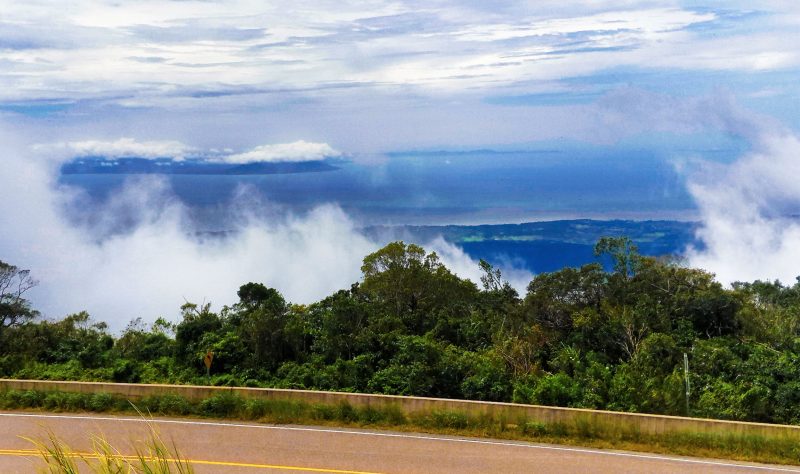
You can reach the resort town of Sihanoukville by taxi or minivan taking national highways No. 4, No. 41, No. 3, or No. 31.
If you choose that bus, then take an additional blanket with you, as well as a hoody and a reel of sticky tape. At night the driver turns on the air conditioning to the max and you feel like it’s minus 16 degrees. I found myself in a sleeping compartment with broken ventilators that blew ice-cold air all night — that’s what you might need sticky tape for.
Sleeping compartments are meant for two persons, so I advise solo travelers to buy two seats in order to sleep more comfortably. Come to mention it, I almost never managed to actually fall asleep during a night ride, so after a couple of trips I switched to day buses.

Highway No. 4 takes you through picturesque mountains and hills, but there’s more than plenty of that beauty around Sihanoukville.
How to get there from the airport
So you have flown into the town of Sihanoukville. You can take a plane from Phnom Penh or Siem Reap. The flight takes about 40 minutes to one hour.
Taxis
You can take a taxi at the airport straight to your hotel. The price is around $20 depending on the distance of the beach where you booked your accommodation.
Tuk-tuks
If you exit the airport territory with a suitcase you can look for a tuk-tuk — a motorbike with some sort of cabin attached. There are three types. The most comfortable tuk-tuk resembles a carriage — this is the ‘old’, colonial type.
The second type is the Indian tuk-tuk — this is a three-wheeled little car, and rather cramped.

If you exit the airport territory with a suitcase you can look for a tuk-tuk — a motorbike with some sort of cabin attached. Photo: Anna Jedynak / Shutterstock.com
There are also most unusual cadavers, a third type that is now very rare — this is when a full-size cabin is fixed to a low-engine car such as a Hyundai Getz. The result is a rather amusing but perfectly practical means of transport.
You should haggle over the price for any transport that you hire beyond the airport gates, and you should be able to get the price down by $1-10.

You should haggle over the price for any transport that you hire beyond the airport gates, and you should be able to get the price down by $1-10. Photo: VladyslaV Travel photo / Shutterstock.com
Where to stay and where to swim
After investments totalling $8.5 billion the town has been totally transformed! It has been cleaned up nicely, although here and there on the outskirts construction is continuing. But wide streets, palm alleys, avenues and pedestrian zones await travelers.
Designer high-rise buildings and condominiums have been built in the center. The town has all types of nighttime entertainment establishments, and over 20 casinos are open — their clientele is mostly Chinese.

After investments totalling $8.5 billion the town has been totally transformed!
Sihanoukville has lots of beaches and by law they are all free of charge and open to the public.
San Beach is closer to the port, but quite barren-looking and has few visitors. It’s far from the center and is unlikely to appeal to European tourists, though it’s more appropriate for locals, albeit not in all weather.
Victory Beach comprises the tourist gates of the resort town. Many ships and motorboats set off from here to the islands, and this is where you can hire a boat and where boats are parked long-term. You can stay in a hotel next to this beach, but there are other more interesting places.
The picturesque Victory Hill, the famous bending palm trees and wonderful sunsets add much to the beach. Admittedly, from time to time the smell of running engines interrupts the fresh sea breeze, or a rainbow-colored film patch on the water holds back your desire to swim.

Victory Beach — comprises the tourist gates of the resort town.
Hawaii Beach is a picturesque and cozy beach next to the road bridge to the island of Koh Puos, literally ‘snake island’. It doesn’t have many visitors, is clean and pleasant, practically in the very center of the town. Khmer families like to take picnics here and go for a paddle in the water (by the way, the locals hardly ever actually go swimming). The beach sports a large number of shaded spots thanks to Caribbean pines.
Independence Beach is one of the town’s longest beaches, and is excellently prepared for the new tourist season. It has been caringly equipped with the required infrastructure and is regularly cleaned. Several expensive hotel franchises are found here. On ‘Independence’ you can already feel the patented Cambodian tranquility and immerse yourself in the transparent waters of the Gulf of Thailand.

Hawaii Beach — is a picturesque and cozy beach next to the road bridge to the island of Koh Puos, literally ‘snake island’. Photo: euvouporai / Shutterstock.com
Sokha Beach is one of the best beaches in Sihanoukville, and is assigned to the local hotel chain Sokha. The sand’s carefully maintained cleanliness, affordable infrastructure, sunbeds and umbrellas make this beautifully tended beach the best choice. The waters are clean, and the sand is white and awaits your touch.
Serendipity Beach and Ou Chheuteal Beach are two heads of the same long stretch of land. The Khmer name is gradually replacing the one long given by the French. The central town beach has always set the standard for cleanliness, and it has also been given a make-over in advance of the post-pandemic season. Cycling lanes, running lanes and a pedestrian zone have been laid out along the palm avenue. Ou Chheuteal Beach sports all sorts of establishments where you can have fun. Accommodation options to suit any budget are located nearby.

The central town beach has always set the standard for cleanliness, and it has also been given a make-over in advance of the post-pandemic season. Photo: Young Swee Ming / Shutterstock.com
Otres Beach completes our tour of Sihanoukville beaches. It’s the longest one and a tiny bit provincial. Here you get the highest concentration of peace and quiet. It’s pretty remote from the town (5 km), and quite appropriate for a family holiday. It provides the full set of required public places and entertainment: hotels, restaurants, shops, massage parlors, bars, street stalls, launderettes and agencies. You can also find all this by other beaches too, but in various concentrations.
A trip along the southern coast: what to see
You can start out on your trip along the coast right from your hotel in Sihanoukville, setting off each morning and returning in the evening or the following morning. Or you can just drive forwards along highway No. 3, visiting town after town.
There are hotels in both Kep and Kampot, and it’s easy to book them in advance.
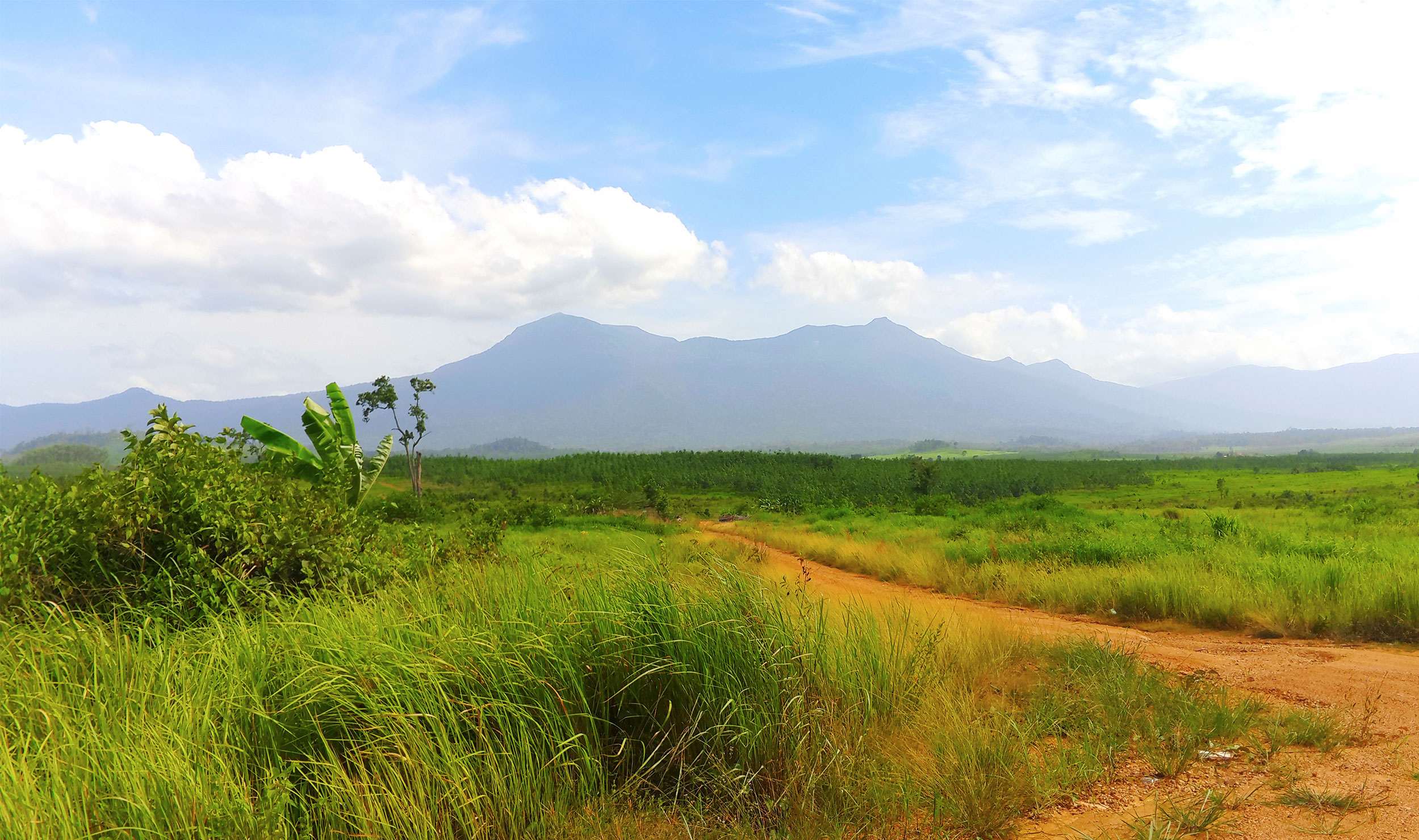
You can start out on your trip along the coast right from your hotel in Sihanoukville, setting off each morning and returning in the evening or the following morning.
Plateau Bokor
You can get to the Plateau on a motorbike hired in the town, but the journey will be exhausting. You will spend an hour and a half riding through picturesque surroundings, then another hour driving up the winding mountain road (all the roads are new and the winding road has a barrier), so we recommend taking a one-day car tour with a local guide (the price is $146-200 or higher).
There are a number of wonderful historical places on the plateau and sites to take photos. In colonial times the surroundings were a favorite of the French top brass. The officers gathered here to build themselves dozens of mountain chalets. But then the protectorate suddenly went and ended! The investments hence turned sour — and it’s the same story all along the coast.
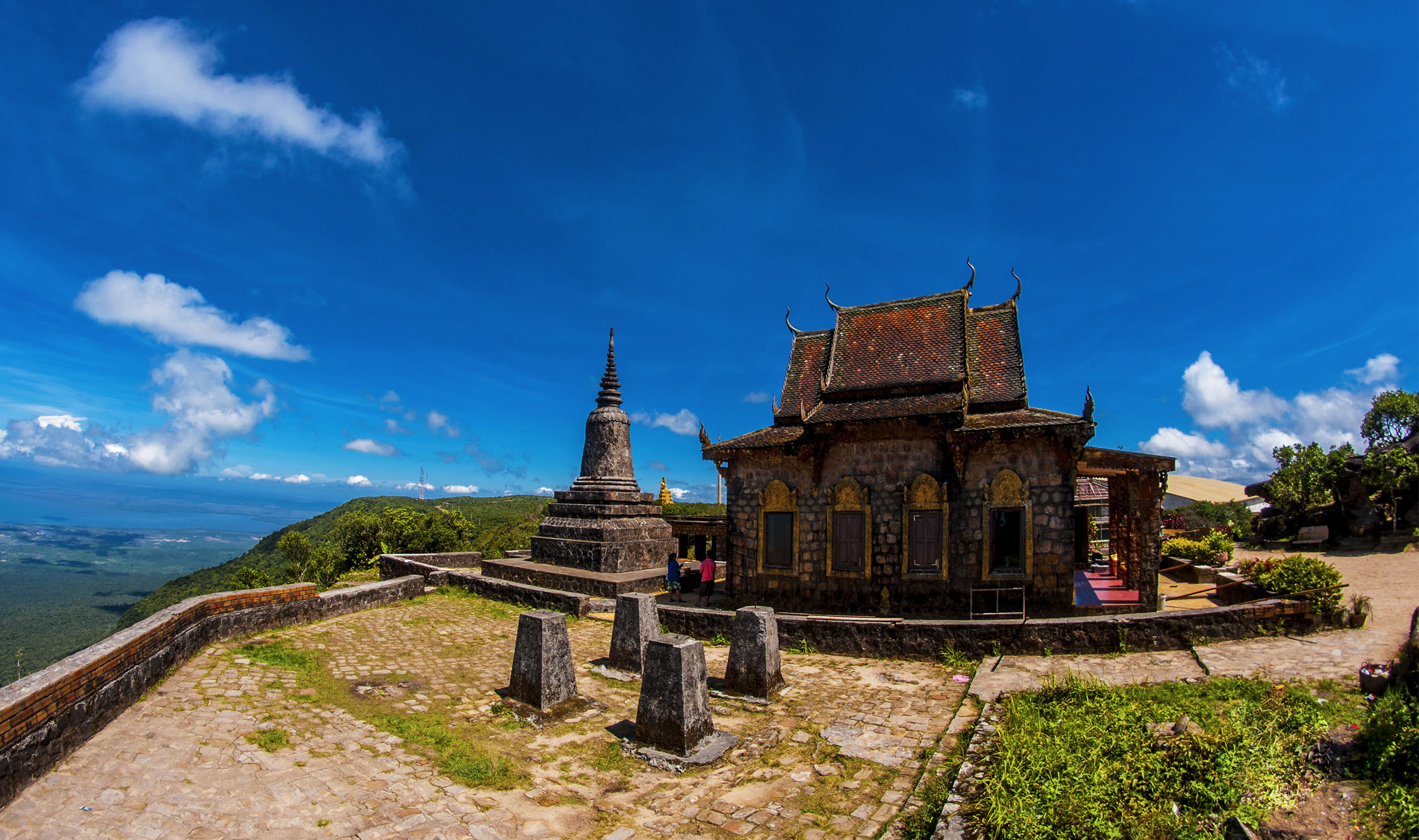
There are a number of wonderful historical places on the plateau and sites to take photos. Photo: Tran Qui Thinh / Shutterstock.com
Clouds ‘wander’ naturally through Plateau Bokor in the morning. It’s extremely easy to find yourself in the atmosphere of a ghost town! In the fog you can just about make out the mystic contours of the old French cathedral or the 5-star Sokha hotel, built over an abandoned royal casino — a wonderful sight. Only a few half-ruined buildings remain of the royal residence that enjoyed its best days in the 1960s – and the guide will tell you its story.
Amazing views of the coast open up from the Buddhist pagoda Wat Sampow Pram — the temple of five boats. How the boats turned up on a kilometer-high mountain plateau is the subject of a local legend.
Basically, there are enough sites to view for an entire day, so this is just the amount of time that we recommend spending on getting to know the place. You will find restaurants and hotels in the little town at the summit.
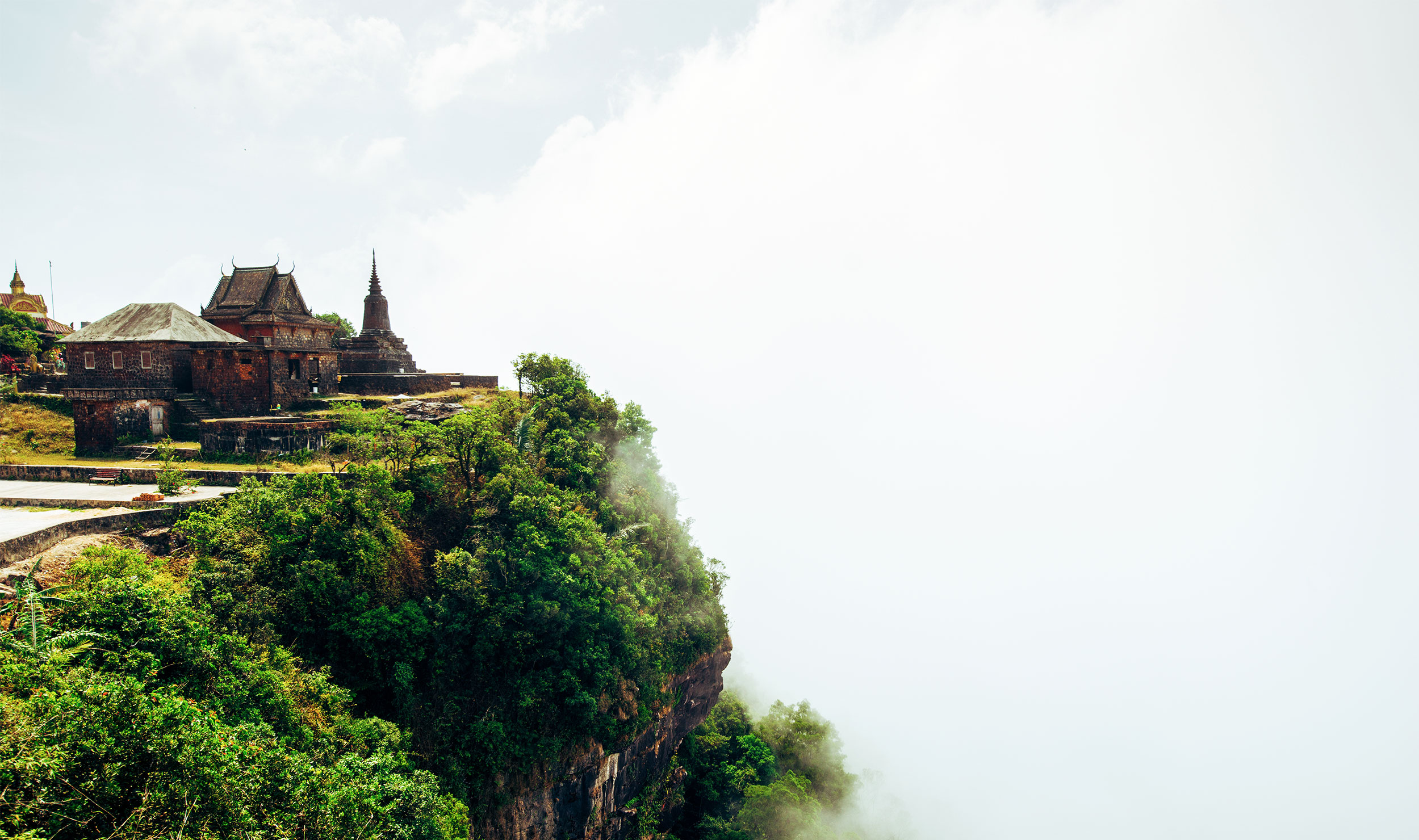
Clouds ‘wander’ naturally through Plateau Bokor in the morning. Photo: Yarygin / Shutterstock.com
Must-sees: the huge monument to the local enchantress and protectress Yeay Mao, the pagoda of five boats mentioned above, the abandoned catholic church with incredible acoustics inside, the tea house of the King of Cambodia Norodom Sihanouk (ruins), the ‘black palace’ of the ruler, the Popokvil Waterfalls, and the rebuilt Bokor Palace hotel.
Don’t miss: the fields of fly traps (with a special shape), the Cave of Ascetics, the ‘portal to another world’ landscape and the Stone of Meditation.

Amazing views of the coast open up from the Buddhist pagoda Wat Sampow Pram — the temple of five boats. Photo: Nhut Minh Ho / Shutterstock.com
Khmer Kampot
A great new road from Sihanoukville will take you to Kampot, highway No. 3. It’s 100 km between the towns. The town itself hosts a bunch of boutique hotels, many of which are available on ZenHotels.
Kampot is the colonial heart of Cambodia’s southern coast. It’s a town that has preserved its style, design and structure, which the French reproduced in their estates as though from a photocopier. And they didn’t build haphazardly: all the properties, the width of the streets, the height of the buildings, the sizes of windows and doors — all this was designed by specialized institutes.

Kampot is the colonial heart of Cambodia’s southern coast. Photo: Nhut Minh Ho / Shutterstock.com
You start to sense the atmosphere of this place towards the evening. Charming street lights are turned on, old Frenchmen and their young Khmer wives and kids come out onto the streets and take their places in the many cafes, bistros and pizza outlets. People start smoking pipes with fragrant contents, and they cork open a bottle of Chablis.
Other by now tired well-to-dos — downshifters and digital nomads who love Cambodia for its low accommodation prices and comfortable visa regime — pour out of their air-conditioned apartments of the end of the 19th century and head for the seafront.
The town sports a vast amount of showrooms, workshops, boutiques and street stalls with enchanting contents. You can’t admire all of these riches in a single evening.

You start to sense the atmosphere of this place towards the evening. Photo: Merel Tuk / Shutterstock.com
Make sure to take a historical town tour — you will learn lots of interesting things about the mores and everyday life of opium traders, about the house of amputated fingers, and about where the leading French novelist Marguerite Duras lived.
Such tours cost $50-100 if you order them from sites of local guides. If you have good English and a wonderful imagination, you can order a similar tour from an agency in the street, the price will be lower, but the contents will be less informative.
Kampot is all about feeling and enjoying life, immersing yourself in its atmosphere and having a cool time.
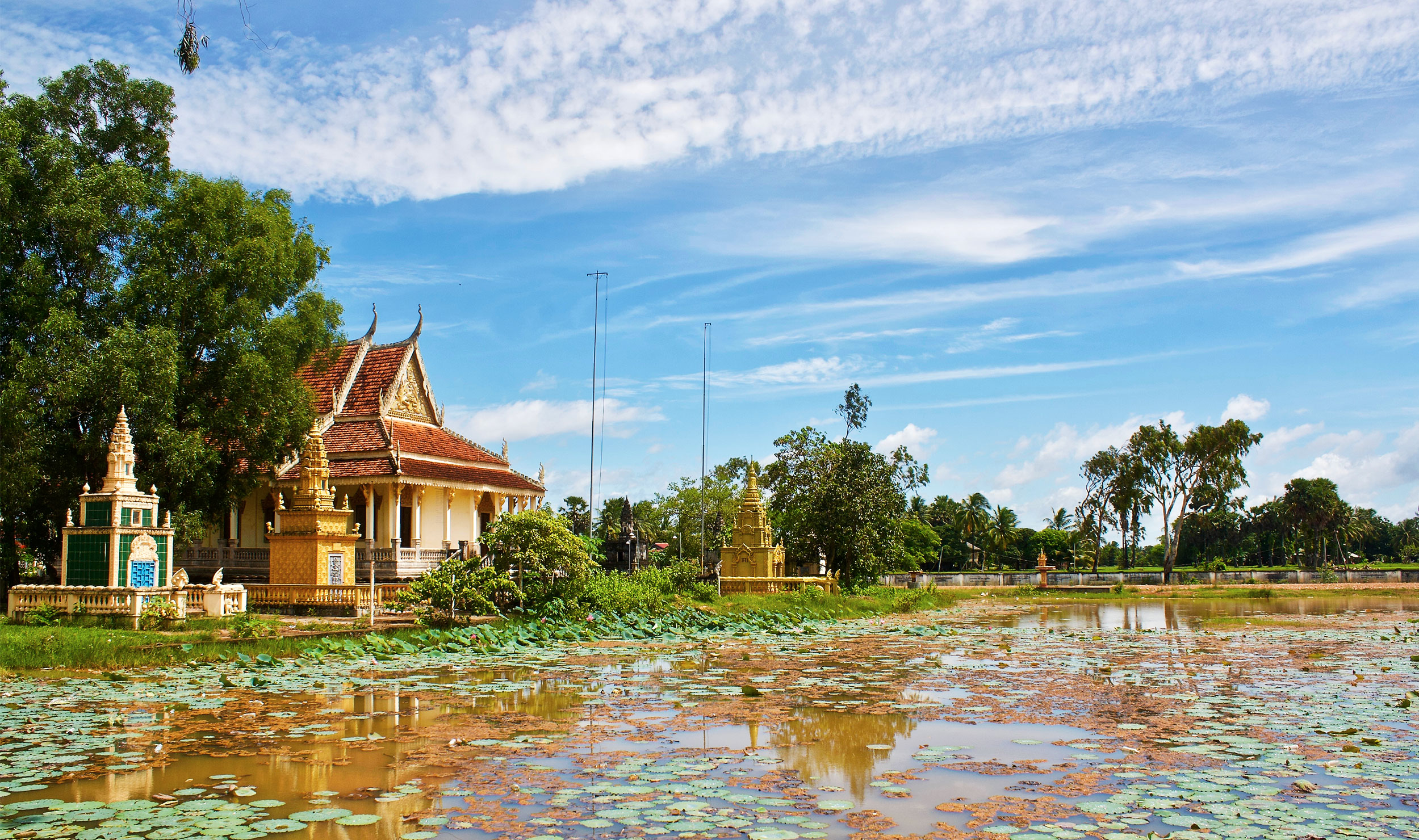
Kampot is all about feeling and enjoying life. Photo: Juan Carlos Herrera / Shutterstock.com
Crunchy, crabby Kep
We continue our journey along highway No. 3. Remember I promised you some gastronomic treats at the beginning of my article? Their time has come: please welcome the crown jewels of Khmer cuisine — blue king crabs from the town of Kep as well as aromatic pepper from the province of Kampot (this is where we happen to be).
The crabs are sold at the fish market together with other seafood — they have everything there! Everything that the Gulf of Thailand has to offer can be found at these stalls.

The crabs are sold at the fish market together with other seafood — they have everything there! Photo: Sophie Lenoir / Shutterstock.com
The simple way to enjoy the crabs: you hire a wooden gazebo right at the beachfront and order some seafood from the market traders — they will cook it to perfection and serve it with the famous white pepper sauce. It costs from $2.50-3 and the seafood is delivered regularly. Or you can head to any little restaurant beyond the market — they will serve you the same dish, but it will cost more.
White pepper is a magical food that the Khmer have grown since the 9th century on volcanic soil around a dormant volcano. Brateak Krola Lake has formed in its cooled and ground-level crater. This soil is rich in minerals and has a unique geological benchmark.

White pepper is a magical food that the Khmer have grown since the 9th century on volcanic soil around a dormant volcano. Photo: Visualize Creative / Shutterstock.com
Foodies may taste totally new savory hints of camphora and lemon rind in dishes cooked with this spice. Needless to say, lovers of delicacies greedily grabbed these lands, bought them up, broke up the plantations and sell almost the entire white pepper harvest to France — where it ends up in Michelin restaurants.
This special land is limited in quantity, and the price per hectare reaches $100,000, which is California level. Moreover, after the regional certificate was awarded in 2010 there is almost no available land left.
Of 20 tonnes of harvest, 10 tonnes are exported to France (sometimes more, sometimes less), while the other 10 tonnes remain on the local market.

Foodies may taste totally new savory hints of camphora and lemon rind in dishes cooked with this spice. Photo: JM Travel Photography / Shutterstock.com
Let me tell you a secret: there are another four types of pepper — black, red and bird. The differences between them is not information to be shared.
The town sports a number of interesting trekking routes, a Butterfly Farm, and several Buddhist pagodas, but it lacks Kampot’s atmosphere. Most visitors staying here are family couples who hire apartments for a length of time.
Must-sees: Kepа crab market, and at least one of the pepper plantations (La Plantation, Starling Farm, or Kampot Pepper).

Must-sees: Kepа crab market. Photo: Lizavetta / Shutterstock.com
Caves and the weathered stone
I recommend allocating more time than anything else to Kampong Trach or, if tiredness is getting the better of you, to invest all you’ve got in this location. Here you will find wonderful little cubby holes, uninhabited caves, fantastic views, unexpected crossings — a true place of energy.
Kampong Trach is a set of natural caves formed as a result of weather erosion of a rocky part of land. The caves are connected by a trekking path, and you can visit them all in a couple of hours: admire the stalagmites sparkling with salt, and view the weathered rocky peaks dominating the greenery in the rice fields.
You don’t need to take any special equipment other than trainers with you, but you can hire equipment in some of the caves, and instructors are available to help you conquer some of the shorter rock formations.

Kampong Trach — is a set of natural caves formed as a result of weather erosion of a rocky part of land.
Must-sees:
- Kampong Trach Caves;
- Phnom Chhngok Cave Temple (a cave with a Khmer temple dating to the 9th century inside it);
- Salt Fields Kampot (next to Kampot grotto);
- Ta Da Roung Chan Waterfall;
- Phnom Kbal Romeas (with equipment).
Charming remote locations:
- Brateak Krola Lake (a lake where you can go for a snack or for lunch, next to a pepper plantation);
- Wiel Pui Waterfall;
- Veal Pouch Waterfall;
- Teuk Chhou Rapids;
- Led Zep Cafe (a three-hour trek along Kep mountain with many locations and solitary places);
- Butterfly Garden in the town of Kep.
Once you get to Kampong Trach your investigation of the southern coast comes to an end, as you will have seen everything. After that you can head straight for Vietnam or turn back to Sihanoukville.
Photos by Alexander Shlotov


